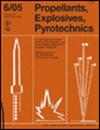双金属热敏镍/铝/Fe2O3 体系的燃烧特性和烟火切割效果研究
IF 1.7
4区 工程技术
Q3 CHEMISTRY, APPLIED
引用次数: 0
摘要
纳米热敏电阻因其高能量释放率而成为复合高能材料领域备受关注的课题。为满足不同的工程需求,热敏电阻配方通常会根据特定标准进行定制。本研究探讨了金属镍(Ni)作为添加剂对纳米热敏电阻配方进行改性的潜力。采用湿球研磨法,将纳米铝(Al)和氧化铁(Fe2O3)等基础材料与不同质量比例的镍(1%、3%、5%、7%、9%)混合。通过扫描电子显微镜和 XRD 表征测试,仔细观察了反应前和反应后所得热敏样品的形态和成分变化。此外,还进行了 DSC 分析和燃烧实验,以检查所评估样品的热解和燃烧行为。结果表明,引入镍后,DSC 曲线上的放热峰降低,与 Al/Fe2O3 热敏剂相比,液固(L-S)相反应更具挑战性。耐人寻味的是,随着镍质量比的增加,镍的加入会逐渐降低热敏电阻的燃烧温度,在不锈钢板穿孔试验中,镍的效率峰值为 7%。这项研究进一步揭示了热敏电阻的反应机制是 "预燃-聚变 "和 "聚变-扩散 "机制的综合结果。这些见解可为设计热敏电阻配方提供有价值的指导,以便将其潜在应用于储存、管理和烟火切割领域。本文章由计算机程序翻译,如有差异,请以英文原文为准。
Study on combustion characteristics and pyrotechnic cutting effects of bimetal thermite Ni/Al/Fe2O3 system
Nano‐thermite has become a subject of significant interest in the composite energetic materials field due to its high energy release rate. To cater to diverse engineering needs, thermite formulations are often customized to fulfill specific criteria. This study investigates the potential of metal nickel (Ni) as an additive to modify nano‐thermite formulations, selected for its optimal calorific values and chemical reactivity. The base materials, nano‐aluminum (Al) and iron oxide (Fe2O3), are blended with varying mass ratios of Ni (1 %, 3 %, 5 %, 7 %, 9 %) using the wet ball milling method. Pre‐reaction and post‐reaction morphological and compositional alterations in the resultant thermite samples are scrutinized through SEM and XRD characterization tests. Moreover, DSC analysis and combustion experiments were conducted to examine the pyrolysis and combustion behaviors of the evaluated samples. The results reveal a reduced exothermic peak on the DSC curves with the introduction of Ni, making the liquid‐solid (L‐S) phase reaction more challenging compared to the Al/Fe2O3 thermite. Intriguingly, Ni addition progressively decreases the combustion temperature of thermites as the Ni's mass ratio increases, with a peak efficiency at 7 % in the perforation tests on stainless‐steel plates. This research further reveals that the thermite reaction mechanism is a combined consequence of the “pre‐ignition‐fusion” and “fusion‐diffusion” mechanisms. These insights can provide valuable guidance for designing thermite formulations for potential applications in storage, management, and pyrotechnic cutting areas.
求助全文
通过发布文献求助,成功后即可免费获取论文全文。
去求助
来源期刊

Propellants, Explosives, Pyrotechnics
工程技术-工程:化工
CiteScore
4.20
自引率
16.70%
发文量
235
审稿时长
2.7 months
期刊介绍:
Propellants, Explosives, Pyrotechnics (PEP) is an international, peer-reviewed journal containing Full Papers, Short Communications, critical Reviews, as well as details of forthcoming meetings and book reviews concerned with the research, development and production in relation to propellants, explosives, and pyrotechnics for all applications. Being the official journal of the International Pyrotechnics Society, PEP is a vital medium and the state-of-the-art forum for the exchange of science and technology in energetic materials. PEP is published 12 times a year.
PEP is devoted to advancing the science, technology and engineering elements in the storage and manipulation of chemical energy, specifically in propellants, explosives and pyrotechnics. Articles should provide scientific context, articulate impact, and be generally applicable to the energetic materials and wider scientific community. PEP is not a defense journal and does not feature the weaponization of materials and related systems or include information that would aid in the development or utilization of improvised explosive systems, e.g., synthesis routes to terrorist explosives.
 求助内容:
求助内容: 应助结果提醒方式:
应助结果提醒方式:


